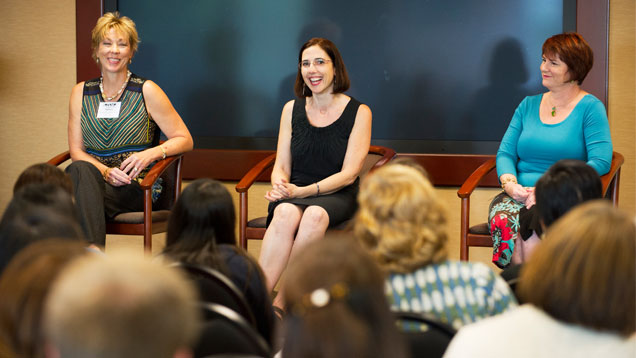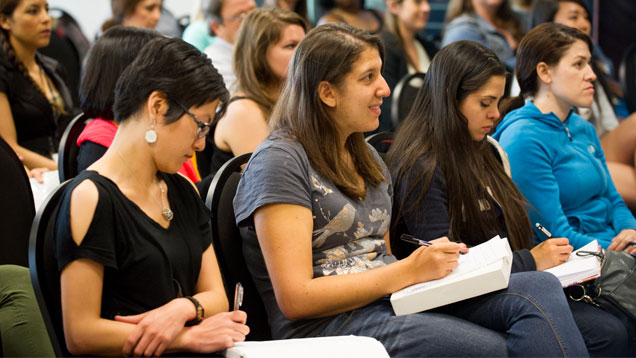Inside the World of Gem and Jewelry Appraising
July 11, 2014

“We are perpetual students. We are always learning, and we love it,” said Teri Brossmer, an independent appraiser and GIA Graduate Gemologist (GG), who kicked off a panel discussion along with two other appraisers from the American Society of Appraisers (ASA). A drive to continue your education is vital for appraisers because you regularly spend time studying new discoveries, learning about gem treatments and understanding the laws that affect your business, she said.
Brossmer got her start in gems and jewelry in 1979 when she approached a local jeweler and asked how she could make a career in the industry. He suggested she contact GIA. When Brossmer returned to the store with a course catalog the jeweler was so impressed by her initiative that he hired her on the spot. She earned her GG and ultimately received her appraising accreditation through ASA.
Brossmer said appraisers use their gemological and jewelry knowledge, combined with valuation theory – a process to determine the monetary market value – to give a credible, defendable opinion of value. She pointed out that unlike other jewelry professionals, appraisers don’t have a particular product to sell.
“We’re selling our experience, knowledge and opinion,” she said. “I get paid for my opinion – but it is a well-researched opinion.”
Appraisers don’t just get to be opinionated and curious, she told students; they need to have a variety of skills.
“Appraisers need to be multi-talented,” she said. They need to be part scientist, part computer tech, part business person, and part historian. History skills come into play when they recognize gem treatment and jewelry techniques, and spot when something is out of place.
“You’ve got to know that when you turn over the incredible ‘art nouveau’ piece and see the CAD/CAM skin on the back, you’ve got a problem,” Brossmer said. “You need to know when certain techniques were possible throughout history.”
She added that aspiring appraisers also need to be part diplomat, or as she put it, a “jewelry therapist,” since jewelry is often purchased to commemorate a significant occasion and frequently has special meaning attached to it.
She shared the story of one of her first clients, a recently engaged woman who brought in her ring to be appraised. Brossmer, unfortunately, immediately recognized the stone was not a diamond and told her client, who was shocked. “After that, I learned diplomacy very quickly,” she said.
Brossmer has expanded her expertise to include appraisals for law enforcement organizations. She branched out early in her career when an FBI agent told her about a new law that required seized property to be evaluated by independent appraisers. Brossmer evaluated hundreds of pieces of jewelry for her first case, and the FBI was happy with her work.
“Before long I was getting calls from the FBI, DEA, U.S. Customs and even the Food and Drug Administration,” she said. “As it turns out, appraising seized property is very big business.”
Brossmer said every day can be a new experience for appraisers, especially working with law enforcement. She often works in remote warehouses without heat or air-conditioning, sometimes in temperatures near freezing or above 90 degrees Fahrenheit. On several occasions she’s had to testify in criminal cases, and a few times she’s been involved with evaluating gems and jewelry immediately after a police raid.
Students listened in awe to Brossmer’s unusual experiences and thrilling cases with law enforcement, before two other appraisers joined her for a panel discussion led by student questions.

Students listen attentively and take notes during a panel discussion on gem and jewelry appraising. Photo by Kevin Schumacher/GIA
Carole C. Richbourg, an independent appraiser from Los Altos, California, started her career in a retail jewelry store. She earned her GG diploma through distance education and started her own appraisal business in 2004, working almost exclusively with private consumers in northern California.
Gina D’Onofrio, originally from Sydney, Australia, said she “fell into the appraisal business” after a breadth of jewelry experiences – from selling opals to antique jewelry, and from retail management to jewelry design. She said once she studied gemology she was hooked. “Little did I know my experience was becoming very well-rounded and was setting me up for a good knowledge base for appraising jewelry,” she said.
Students asked the appraisers specific questions about how to increase their knowledge in antique jewelry, how to start an appraisal business, what computer software to use and their favorite gemological instruments.
Richbourg encouraged students to get retail experience, which she said is invaluable because it provides the opportunity to handle jewelry and become more familiar with the “feel” of it. This helps appraisers make an instinctual first determination on authenticity.
D’Onofrio stressed the importance of networking, and the friendships that can often lead to new professional opportunities.
All three of the appraisers said that one of the most rewarding experiences of appraising comes from the stories gems and jewelry reveal. One of Brossmer’s favorite experiences was the opportunity to document American actress Ginger Rogers’ personal jewelry collection.
“Not only did I get to see this personal glimpse into her life, but because she had been a star for such a long span of time, you could see the progression of jewelry design over the years. There were incredible pieces from the 1930s, 1940s and 1950s,” she said.
D’Onofrio admitted she is a hopeless romantic. “I love the discovery, the history, the stories behind the jewelry and the people you meet. I think it’s the best part of the industry.”
About the Author
Kristin A. Aldridge, a writer at GIA, is a graduate of GIA’s Pearls and Accredited Jewelry Professional programs.
.jpg)


